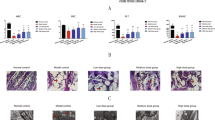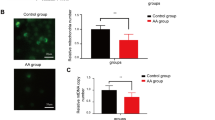Abstract
Objective
To investigate the potential efficacy of panaxadiol saponins component (PDS-C) in the treatment of aplastic anemia (AA) model mice.
Methods
Totally 70 mice were divided into 7 groups as follows: normal, model, low-, medium-, high-dose PDS-C (20, 40, 80 mg/kg, namely L-, M-, H-PDS-C), cyclosporine (40 mg/kg), and andriol (25 mg/kg) groups, respectively. An immune-mediated AA mouse model was established in BALB/c mice by exposing to 5.0 Gy total body irradiation at 1.0 Gy/min, and injecting with lymphocytes from DBA mice. On day 4 after establishment of AA model, all drugs were intragastrically administered daily for 15 days, respectively, while the mice in the normal and model groups were administered with saline solution. After treatment, the peripheral blood counts, bone marrow pathological examination, colony forming assay of bone marrow culture, T lymphocyte subpopulation analysis, as well as T-bet, GATA-3 and FoxP3 proteins were detected by flow cytometry and Western blot.
Results
The peripheral blood of white blood cell (WBC), platelet, neutrophil counts and hemoglobin (Hb) concentration were significantly decreased in the model group compared with the normal group (all P<0.01). In response to 3 dose PDS-C treatment, the WBC, platelet, neutrophil counts were significantly increased at a dose-dependent manner compared with the model group (all P<0.01). The myelosuppression status of AA was significantly reduced in M-, H-PDS-C groups, and hematopoietic cell quantity of bone marrow was more abundant than the model group. The colony numbers of myeloid, erythroid and megakaryocytic progenitor cells in the model group were less than those of the normal mice in bone marrow culture, while, PDS-C therapy enhanced proliferation of hematopoietic progenitor cells by significantly increasing colony numbers (all P<0.01). Furthermore, PDS-C therapy increased peripheral blood CD3+ and CD3+CD4+ cells and reduced CD3+CD8+ cells (P<0.05 or P<0.01). Meanwhile, PDS-C treatment at medium- and high doses groups also increased CD4+CD25+FoxP3+ cells, downregulated T-bet protein expression, and upregulated GATA-3 and FoxP3 protein expressions in spleen cells (P<0.05).
Conclusion
PDS-C possesses dual activities, promoting proliferation hematopoietic progenitor cells and modulating T lymphocyte immune functions in the treatment of AA model mice.
Similar content being viewed by others
References
Young NS, Scheinberg P, Calado RT. Aplastic anemia. Curr Opin Hematol 2008;15:162–168.
Young NS. Hematopoietic cell destruction by immune mechanisms in acquired aplastic anemia. Semin Hematol 2000;37:3–14.
Gao RL, Xu CL, Jin JM, Ma FS, Wang WT. Effect of total saponins of Panax ginseng on hematopoietic progenitor cells in normal human and aplastic anemia patients. Chin J Integr Tradit West Med (Chin) 1992;12:261–262, 285–287.
Chen XH, Gao RL, Xu WH. Effect of ginsenosides in inducing proliferation and transcription factor of erythrocytic, granulo-monocytic and megakarocytic cell lines. Chin J Integr Tradit West Med (Chin) 2001;21:40–42.
Gao RL. Research and development of new Chinese materia medica for treatment of refractory hematopathy by establishment and application of multiple technique platforms. Chin J Integr Med 2007;13:95–97.
Jin JM, Tao H, Gao RL, Chong BH. Effect of ginsenosides on proliferation and differentiation of human CD34+ hematopoietic stem/progenitor cells. Chin J Integr Tradit West Med (Chin) 2000;20:673–676.
Fang GL, Gao RL, Lin XJ, Jin JM. Effects of Ginseng panaxadiol saponin on proliferation and differentiation of human bone marrow CD34+ cells. J Exp Hematol (Chin) 2007;15:776–779.
Gao RL, Chen XH, Lin XJ, Qian XD, Xu WH, Chong BH. Effects of notoginosides on proliferation and upregulation of GR nuclear transcription factor in hematopoietic cells. Acta Pharmacol Sin 2007;28:703–711.
Shen YP, Zhou YH, Yu RX. Clinical observation of total saponins of Panax ginseng in combination with cyclosporin A for treatment of chronic aplastic anemia. J Zhejiang Clin Med (Chin) 2001;23:178–179.
Qian XD, Ma FS, Gao RL. Efficacy observation of Shengxue- ling Capsule (total saponins of Panax ginseng) in treating chronic aplastic anemia. J Zhejiang Clin Med (Chin) 2004;6:952–953.
Gao RL, Chong BH. Research and development of the effective components of panaxdiol saponin as new Chinese patent medicine for treating hemocytopenia. Chin J Integr Med 2012;18:897–902.
Wen WW, Sun X, Zhuang HF, Lin XJ, Zheng ZY, Gao RL, et al. Effects of panaxadiol saponins component as a new Chinese patent medicine on proliferation, differentiation and corresponding gene expression profile of megakaryocytes. Chin J Integr Med 2016;22:28–35.
Lin X, Yin L, Gao R, Liu Q, Xu W, Jiang X, et al. The effects of panaxadiol saponins on megakaryocytic maturation and immune function in a mouse model of immune thrombocytopenia. Exp Hematol 2015;43:364–373.
Kuang YM, Zhu Y, Gao RL, Hu J, Jiang ZY, Huang L, et al. Clinical study of Pai-neng-da Capsule in the treatment of chronic aplastic anemia. Chin J Integr Med 2016;22:124–129.
Yin LM, Jiang HF, Wang X, Qian XD, Gao RL, Lin XJ, et al. Effects of sodium copper chlorophyllin on mesenchymal stem cell function in aplastic anemia mice. Chin J Integr Med 2013;19:360–366.
Sun X, Gao RL, Lin XJ, Xu WH, Chen XH. Panax notoginseng saponins induced up-regulation, phosphorylation and binding activity of MEK, ERK, AKT, PI-3K protein kinases and GATA transcription factors in hematopoietic cells. Chin J Integr Med 2013;19:112–118.
Kordasti S, Marsh J, Al-Khan S, Jiang J, Smith A. Mohamedali A, et al. Functional characterization of CD4+ T cells in aplastic anemia. Blood 2012;119:2033–2043.
Zeng W, Kajigaya S, Chen G, Risitano AM, Nunez O, Young NS. Transcript profile of CD4+ and CD8+ T cells from the bone marrow of acquired aplastic anemia patients. Exp Hematol 2004;32:806–814.
Dezern AE, Brodsky RA. Clinical management of aplastic anemia. Expert Rev Hematol 2011;4:221–230.
Sheng W, Liu C, Fu R, Wang H, Qu W, Ruan E, et al. Abnormalities of quantities and functions of linker for activations of T cells in severe aplastic anemia. Eur J Haematol 2014;93:214–223.
Solomou EE, Rezvani K, Mielke S, Malide D, Keyvanfar K, Visconte V, et al. Deficient CD4+ CD25+ FOXP3+ T regulatory cells in acquired aplastic anemia. Blood 2007;110:1603–1606.
Liu WB, Li S, Yu XL, Dai TY, Gao RL. Research progress on Chinese medicine immunomodulatory intervention for chronic primary immune thrombocytopenia: targeting cellular immunity. Chin J Integr Med 2019;25:483–489.
Calado RT, Yewdell WT, Wilkerson KL, Regal JA, Kajigaya S, Stratakis CA, et al. Sex hormones, acting on the TERT gene, increase telomerase activity in human primary hematopoietic cells. Blood 2009;114:2236–2243.
Tang Y, Desierto MJ, Chen J, Young NS. The role of the Th1 transcription factor T-bet in a mouse model of immunemediated bone-marrow failure. Blood 2010;115:541–548.
Solomou EE, Keyvanfar K, Young NS. T-bet, a Th1 transcription factor, is up-regulated in T cells from patients with aplastic anemia. Blood 2006;107:3983–3991.
Kaito K, Otsubo H, Usui N, Kobayashi M. Th1/Th2 lymphocyte balance in patients with aplastic anemia, Rinsho byori. Jpn J Clin Pathol 2004;52:569–573.
Rengarajan J, Szabo SJ, Glimcher LH. Transcriptional regulation of Th1/Th2 polarization. Immunol Today 2000;21:479–483.
Annacker O, Pimenta-Araujo R, Burlen-Defranoux O, Bandeira A. On the ontogeny and physiology of regulatory T cells. Immunol Rev 2001;182:5–17.
Chen J, Ellison FM, Eckhaus MA, Smith L, Keyvanfar K, Calado RT, et al. Minor antigen h60-mediated aplastic anemia is ameliorated by immunosuppression and the infusion of regulatory T cells. J Immunol 2007;178:4159–4168.
Garg R, Faderl S, Garcia-Manero G, Cortes J, Koller C, Huang X, et al. Phase II study of rabbit anti-thymocyte globulin, cyclosporine and granulocyte colony-stimulating factor in patients with aplastic anemia and myelodysplastic syndrome. Leukemia 2009;23:1297–1302.
Author information
Authors and Affiliations
Contributions
Gao RL, Zheng ZY and Chong BH conceived of the study, designed, supervised the experiments and wrote the manuscript. Yu XL performed preparation and analysis of PDS-C. Dai TY, Yin LM, Zhao YN, Xu M and Zhuang HF performed animal and cell experiments.
Corresponding author
Additional information
Conflict of Interest
The authors declare that they have no conflict of interest
Supported by the National Natural Science Foundation of China (No. 81774068), Medical and Health Key Project of Zhejiang Province (No. 2011ZDA021), Zhejiang Provincial Natural Science Foundation of China (No. LY14H280004)
Rights and permissions
About this article
Cite this article
Zheng, Zy., Yu, Xl., Dai, Ty. et al. Panaxdiol Saponins Component Promotes Hematopoiesis and Modulates T Lymphocyte Dysregulation in Aplastic Anemia Model Mice. Chin. J. Integr. Med. 25, 902–910 (2019). https://doi.org/10.1007/s11655-019-3049-z
Accepted:
Published:
Issue Date:
DOI: https://doi.org/10.1007/s11655-019-3049-z




